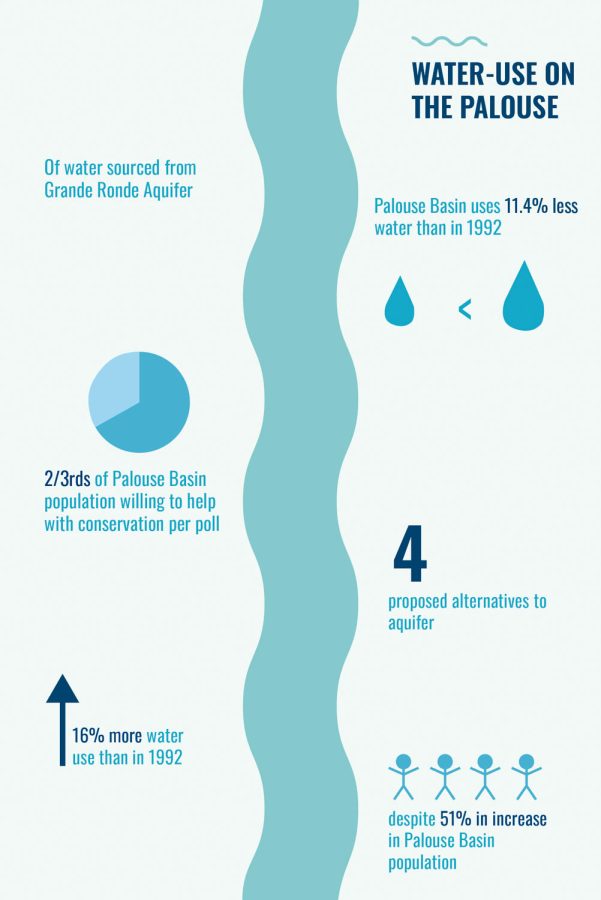Local organization fights for water conservation, sustainable aquifer solutions
Pullman population has grown 51%; groundwater pumping has only increased 16%
April 13, 2022
The Palouse region’s primary water source is declining seven-tenths of a foot each year, and a volunteer committee aims to make it more sustainable through alternative water sources.
The Palouse Basin Aquifer Committee’s mission is to ensure a long-term, quality water supply for the Palouse region, according to the committee’s website.
The Palouse sources all of its drinking water from two groundwater aquifers, said Paul Kimmell, PBAC communications subcommittee chair and Avista Utilities business and public affairs manager.
“[An aquifer] lies below us in a series of cracks and fissures between volcanic flows of basalt,” Kimmell said. “So it isn’t like there’s just this giant pool of water underneath us — it’s scattered and diverse.”
Communities in the region use wells to drill between these basalt layers and access the drinking water, Kimmell said.
Members of the WSU, University of Idaho, Pullman and Moscow communities formed PBAC in 1967 to address concerns of declining levels of groundwater, Kimmell said.
Since then, PBAC has held a leadership role in water conservation on the Palouse and has grown to encompass the cities of Colfax and Palouse, Kimmell said.
The committee created the Palouse Basin Groundwater Management Plan in 1992 with the goal of conserving water through a communitywide effort, he said.
When the committee began monitoring the annual level of the aquifer’s decline, about a foot and a half of water was being used each year. Today, only seven-tenths of a foot is used each year, he said.
Despite a 51% population growth in Pullman, groundwater pumping has only increased 16%, Kimmell said.
“Things are trending really well, but we’re still in a state of decline,” he said.
WSU and UI have installed shower heads, water faucets and toilets that use less water to help conserve water, Kimmell said.
UI has used treated wastewater to irrigate its fields and lawns since the 1970s, said Robin Nimmer, senior hydrologist, project manager and water resources division leader for Alta Science & Engineering in Moscow.
Nimmer has been involved with PBAC for about a decade, and involved with this project professionally for the last year and a half, she said. Nimmer’s other projects include ground and surface water monitoring, and water supply for individuals and communities.
Despite excellent conservation efforts on the Palouse, the amount of groundwater in the aquifers is significantly declining each year. PBAC wants to find an alternative water source to complement the aquifer, Kimmell said.
One alternative is to divert water from the Snake River, Nimmer said.
The second alternative is to divert water from Paradise Creek and the North Fork of the Palouse River. This water would then be treated in Pullman and piped to Pullman and Moscow, she said.
The third and fourth alternatives both involve diverting water from a local river or creek, treating it in Pullman or Moscow and directly using it in the city it came from, Nimmer said.
Nimmer said she will present her report of the four alternatives to PBAC in June.
“Some basins don’t have the luxury we have. They have to build 100 or 200-mile pipelines,” Kimmell said. “We have sources of water within the basin that we believe we can tap into and help us reduce some of that water use.”
Nimmer said PBAC is weighing each option based on cost, time, environmental impact and other factors.
“We have no bias with one over the other. We’re letting the science, the engineers and the hydrologists guide us through this,” Kimmell said.
In fall 2021, PBAC conducted a poll to gauge the community’s awareness and interest in water conservation efforts, Kimmell said. The poll revealed one-third of respondents were definitely interested in water conservation, one-third were slightly interested and one-third were not interested.
“We have to stay committed as a region,” Kimmell said. “Whether it’s water or air service, there is strength in that regional collaboration.”











